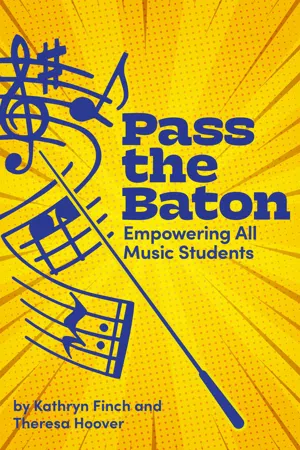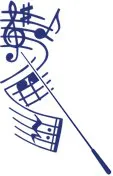
This is a test
- English
- ePUB (mobile friendly)
- Available on iOS & Android
eBook - ePub
Book details
Book preview
Table of contents
Citations
About This Book
Pass the Baton offers readers a comprehensive guide to crafting engaging music lessons that transform students from passive consumers to vibrant creatives. Whether you're looking to rethink general music or overhaul your ensemble groups, Pass the Baton is chock-full of generative, actionable, and impactful tools. Finch and Hoover have drawn on deep research and years of experience in the music room to provide a guide for all music educators to create a learner-centered environment and give students the opportunity to truly own the creative process.
Frequently asked questions
At the moment all of our mobile-responsive ePub books are available to download via the app. Most of our PDFs are also available to download and we're working on making the final remaining ones downloadable now. Learn more here.
Both plans give you full access to the library and all of Perlego’s features. The only differences are the price and subscription period: With the annual plan you’ll save around 30% compared to 12 months on the monthly plan.
We are an online textbook subscription service, where you can get access to an entire online library for less than the price of a single book per month. With over 1 million books across 1000+ topics, we’ve got you covered! Learn more here.
Look out for the read-aloud symbol on your next book to see if you can listen to it. The read-aloud tool reads text aloud for you, highlighting the text as it is being read. You can pause it, speed it up and slow it down. Learn more here.
Yes, you can access Pass the Baton by Kathryn Finch, Theresa Hoover in PDF and/or ePUB format, as well as other popular books in Éducation & Éducation générale. We have over one million books available in our catalogue for you to explore.
Information
Topic
ÉducationSubtopic
Éducation généralePart I
Empowered Music Students

1
It Starts with You

So often we worry about what we can’t do or what we don’t have control over. Usually our schedules are planned and created for us by administrators. Many of us have no control over the size of our ensembles or what time of day they rehearse. Performances are predetermined, and the amount of planning time we get is beyond our control. Sometimes it feels like there are too many constraints in our way for us to make meaningful change. However, we encourage you to think about what you can do. You run rehearsals day after day. You build relationships with students. You create the culture inside the classroom. There is power in your classroom and in your instruction. Use it. It starts with you.
Where to Begin
Before venturing on this journey, take some time to think about your goals for your music students and for your music program. What is your mission statement? What do you want your students to know and be able to do when they leave your program? This will most likely be different for each of us, but we imagine that somewhere at the core, everyone wants their students to be lifelong learners of music. We don’t expect them all to major in music or to become professional musicians. Instead, we hope they’ll find opportunities to create their own music and consume it in their daily lives. We hope they will grow into adults who consider singing in the church choir or playing in a community band or orchestra. They will be parents who sing to their children and encourage participation in musical activities. They will become school board members who fight for music programs when others threaten to make cuts. They will fondly look back at their time in the school music program and recognize its importance, its value, and the impact it made on their lives.
As music teachers, we challenge everyone in our profession to push their thinking and to never stop reflecting on their programs and instruction. We owe that to our students. As educators, we have to stay relevant to them and provide a culture that listens and responds to their needs. We can make a change by giving students ownership, considering their needs first, and empowering them as musicians. That would be life changing.
Scaffolding
Scaffolding will be necessary throughout this process. You will need to provide levels of temporary support as students move toward independence. New information will need to be delivered in small chunks, and routines should be developed so expectations are clear. The supports can be removed incrementally as students progress and no longer need them. If you have a very traditional classroom in a very traditional school, you’ll have to shift instruction gradually to a more student-led experience. Take your time. Make one small shift to begin with, and only make additional shifts when your students have shown they are ready. Don’t get ahead of yourself. It’s a marathon, not a sprint.
This process will also require you to repeatedly reflect. If the shift was a flop, why? What happened? We all make mistakes. What’s great about those experiences is the feedback we receive. What do we keep working on so next time is better? This is a great opportunity to model for our students how to reflect, persevere, and try again. Don’t be afraid to ask them their opinions. What you might consider a flop may have been a win for them!
Be prepared to find that not all of your students will be at the same place at the same time—that would be too easy. Some students will arrive with more experience than others, and therefore they may have different comfort levels. The idea is to meet them where they are. Help each learner get from his or her point A to point B. You will notice throughout this book many strategies offer flexibility. Embrace this!
Modeling
As the teacher, you’ll need to model what you want from your students. If you want them to be creative self-starters who will take a risk and reflect on the process, then you too must push your thinking and have a growth mindset to learn new things. It’s okay and important to share your mistakes and failures with your students. Show how you learned from them and how “fail” doesn’t have to be a bad word. Instead, it’s feedback that pushes thinking forward.
If your students see you as a lifelong learner, it will be easier for them to see themselves that way too. Model growth. They should also see you as a lifelong musician! It’s amazing to us when some students are surprised to hear that we actually play music in addition to teaching it. If you perform outside of school and it’s appropriate, invite your students! If the venue isn’t student friendly, consider showing them a video instead. Our students love seeing videos of us as performers. It makes being a musician seem more real and attainable.
The next time you share accomplishments from a famous composer, consider taking a different approach. Instead of only sharing their great accomplishments, share their failures along the way. Do composers have to overcome hardships and failures before they succeed? Rachmaninoff’s debut of his Symphony No. 1 in D minor received such poor reviews that it sent him into a depressive state and stopped him from composing for a few years. However, he was able to move past this setback and compose Piano Concerto No. 2 in C minor, one of his most popular works. Composer Jennifer Jolley has an entire Instagram page and blog (whycompose.com) dedicated to her rejection letters! Everyone hits bumps along the road; it’s part of the process. How you pick up the pieces and push forward is what’s important.
Building Relationships
It will come up time and time again in this book, but building relationships with your students is vital. As you shift to empowering them, you will find that it requires a certain level of trust. Music teachers will have to trust their students and vice versa. It’s only when this trust has been built that the shift from teacher-directed to student-led learning can occur.
For a music teacher, this can be a challenge because of the number of students you see in a week. Make the effort anyway. Use their names frequently. Smile and say hello in the hallway. Ask about their weekends, after-school activities, or hobbies. So much value and power lies in knowing our students well and beginning to focus our instruction on their likes and needs. When they feel cared for and actively part of a classroom, they thrive. Share about yourself, within reason. Tell them about your interests and hobbies. As mentioned before, share about yourself as a musician. This is how we build trust and model a growth mindset.
Part of our job is to help students see themselves as creative, musical beings. They have something important to say, and not every child inherently knows this. Getting to know students is never a waste of time. Use the conversations you have with them to build on the learning they’re experiencing. For some students, words won’t be enough. They will be angry or hurt and won’t believe your words. For these students, your actions will have more effect. What matters is what you do for them. Ask them to help before or after class with a special task, or make an effort to attend one of their activities after school.
Other students will notice what you did for one of their classmates: how you made an adaptive recorder for a child without breath support or spent the time to find a valuable musical task for a friend of theirs who broke his arm and couldn’t play the ukulele during music class. Every empathetic moment you spend with your students will be rewarding and powerful. It sends the message that in your classroom they are cared for and are to care for others. Sadly, these moments often don’t happen enough, so when you make the effort, it will be noticed and valued.
Learning is social and collaborative. It does not take place in a vacuum. As a result, students will have to trust one another. Allow opportunities for them to build relationships with their classmates and fellow musicians. Taking a cue from social-emotional learning (SEL) strategies, model and practice working collaboratively, giving and receiving feedback, and other skills they will encounter in the music classroom. Help students make the music r...
Table of contents
- Cover
- Praise for Pass the Baton
- Title Page
- Dedication
- Contents
- Foreword
- Introduction
- Part I
- Part II
- Part III
- About the Authors
- More from Dave Burgess Consulting, Inc.